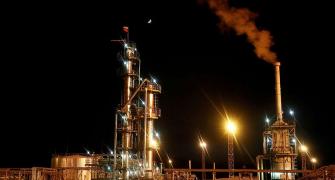Historically, the IIP performance has shown little or no correlation to corporate performances.
 The latest inflation data is in line with Reserve Bank projections.
The latest inflation data is in line with Reserve Bank projections.
The consumer price index (CPI) for September 2015 is up 4.41 per cent over the CPI for September 2014.
The CPI for August 2015 has been revised to reflect 3.74 per cent change over August 2014, instead of the initial 3.66 per cent.
The rise is at least partially due to the ending of favourable base effects. Global crude prices started falling in September 2014, after being high until August 2014. The higher inflation numbers will cause little alarm.
The central bank expects the December 2015 CPI to be 5.8 per cent higher than CPI in December 2014, and this rise is commensurate with estimates, or even a little lower than expected.
The Index of Industrial Production (IIP) data surprised in positive ways. August 2015 IIP is 6.4 per cent higher than August 2014.
The year-on-year (y-o-y) change is at a three-year high. That is strong, even after allowing for obvious base effects.
Over the April-August period, IIP saw a rise of 4.1 per cent, which indicates some revival in activity.
The y-o-y growth in mining, manufacturing and electricity for August 2015 were at 3.8 per cent, 6.9 per cent and 5.6 per cent, respectively.
Cumulative growth in mining, manufacturing and electricity during April-August 2015, over April-August 2014 was 1.2 per cent, 4.6 per cent and 3.2 per cent, respectively. Base effects are clear.
At the use-based level, for example, August 2015 saw capital goods registering growth at 22 per cent over August 2014, when capital goods contracted 10 per cent.
There is also a base effect in consumer goods. In August 2014, consumer goods had seen a dip of six per cent over August 2013, and in August 2015, consumer goods has a gain of 6.8 per cent over August 2014.
As many as 15 of 22 industry groups in manufacturing had positive growth in August 2015, while seven had negative growth. Looking deeper, 'wearing apparel', 'petroleum products', 'fabricated metal products', 'electrical machinery', 'motor vehicles', 'furniture' and 'manufacturing not elsewhere classified' saw growth at 10 per cent.
But food and beverages, tobacco, paper products, publishing and printing, basic metals, communication equipment were negative y-o-y.
From a use-based aspect, growth rates in August 2015 varied a lot between basic goods (3.4 per cent), capital goods (21.8 per cent) and intermediate goods (2.6 per cent).
The variation was equally marked in consumer durables (17 per cent) and consumer non-durables (0.4 per cent).
Consensus opinion suggests the companies represented in the Sensex will register their worst quarterly performance in several years across July-September 2015 with probable falls in earnings. The Sensex30 represents a broad spectrum of activity.
The poor earnings effect might be more marked in big companies, but smaller firms are unlikely to have very positive results. Also, physical exports shrank through the quarter.
How can such negative data and expectations be reconciled with the strong, if uneven IIP data? First, the largest Sensex component - financial companies - would not be directly reflected by IIP data.
Second, IT, which is also a high weight sector, would not be reflected in IIP. But other industries represented in the Sensex are reflected in the IIP.
Historically, the IIP performance has shown little or no correlation to corporate performances.
But apart from statistical quirks caused by the methodology, there is a possibility that the current IIP data will be reflected in positive earnings surprises in specific sectors.
If Sensex numbers reflect the uneven nature of IIP, there will be also be some unpleasant negative surprises, translating into higher than expected earnings and share price volatility.
Photograph: Reuters










